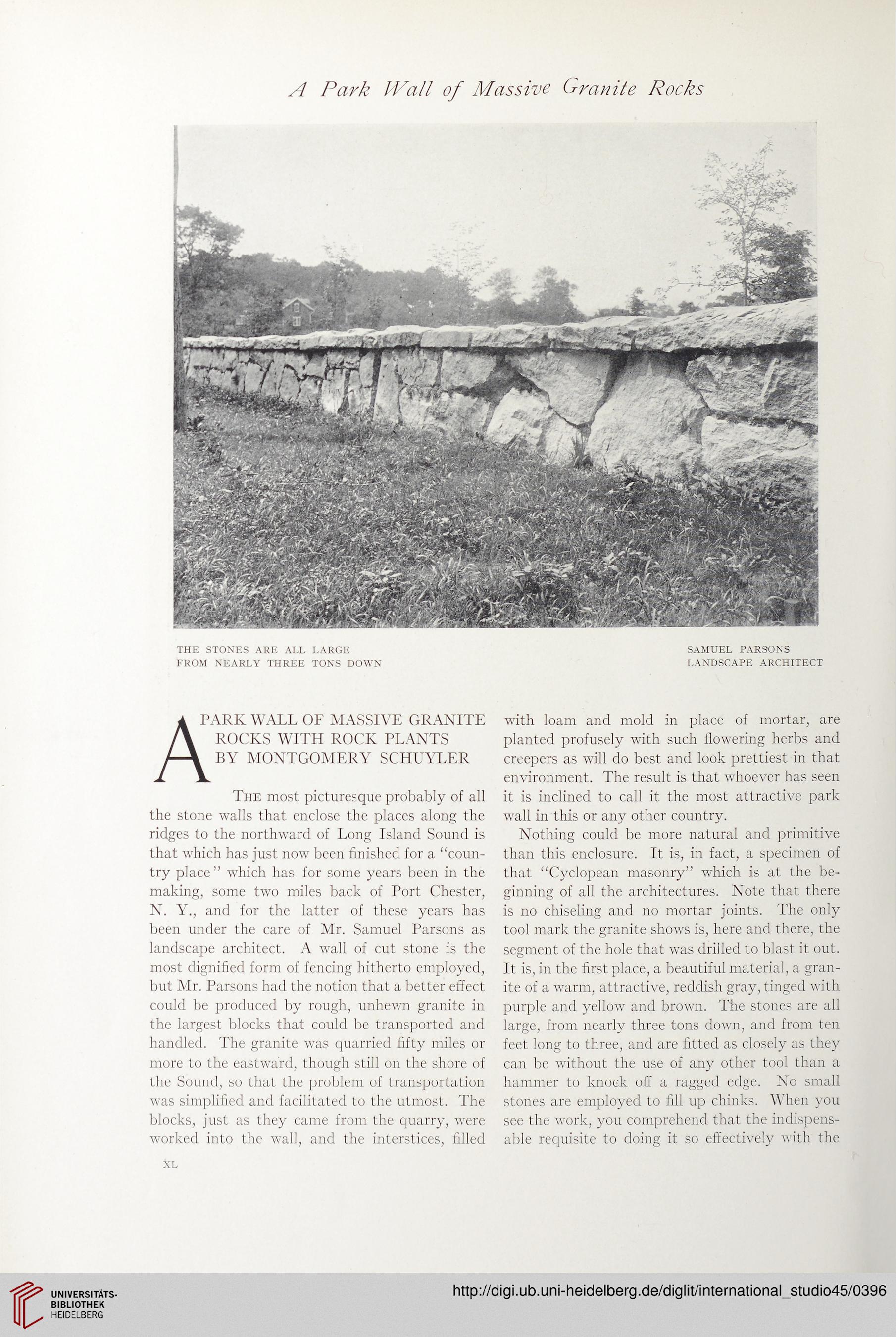A Park Wall of Massive Granite Rocks
THE STONES ARE ALL LARGE
FROM NEARLY THREE TONS DOWN
SAMUEL PARSONS
LANDSCAPE ARCHITECT
4 PARK WALL OF MASSIVE GRANITE
/\ ROCKS WITH ROCK PLANTS
Z—\ BY MONTGOMERY SCHUYLER
The most picturesque probably of all
the stone walls that enclose the places along the
ridges to the northward of Long Island Sound is
that which has just now been finished for a “coun-
try place ” which has for some years been in the
making, some two miles back of Port Chester,
N. Y., and for the latter of these years has
been under the care of Mr. Samuel Parsons as
landscape architect. A wall of cut stone is the
most dignified form of fencing hitherto employed,
but Air. Parsons had the notion that a better effect
could be produced by rough, unhewn granite in
the largest blocks that could be transported and
handled. The granite was quarried fifty miles or
more to the eastward, though still on the shore of
the Sound, so that the problem of transportation
was simplified and facilitated to the utmost. The
blocks, just as they came from the quarry, were
worked into the wall, and the interstices, filled
with loam and mold in place of mortar, are
planted profusely with such flowering herbs and
creepers as will do best and look prettiest in that
environment. The result is that whoever has seen
it is inclined to call it the most attractive park
wall in this or any other country.
Nothing could be more natural and primitive
than this enclosure. It is, in fact, a specimen of
that “Cyclopean masonry” which is at the be-
ginning of all the architectures. Note that there
is no chiseling and no mortar joints. The only
tool mark the granite shows is, here and there, the
segment of the hole that was drilled to blast it out.
It is, in the first place, a beautiful material, a gran-
ite of a warm, attractive, reddish gray, tinged with
purple and yellow and brown. The stones are all
large, from nearly three tons down, and from ten
feet long to three, and are fitted as closely as they
can be without the use of any other tool than a
hammer to knock off a ragged edge. No small
stones are employed to fill up chinks. When you
see the work, you comprehend that the indispens-
able requisite to doing it so effectively with the
XL
THE STONES ARE ALL LARGE
FROM NEARLY THREE TONS DOWN
SAMUEL PARSONS
LANDSCAPE ARCHITECT
4 PARK WALL OF MASSIVE GRANITE
/\ ROCKS WITH ROCK PLANTS
Z—\ BY MONTGOMERY SCHUYLER
The most picturesque probably of all
the stone walls that enclose the places along the
ridges to the northward of Long Island Sound is
that which has just now been finished for a “coun-
try place ” which has for some years been in the
making, some two miles back of Port Chester,
N. Y., and for the latter of these years has
been under the care of Mr. Samuel Parsons as
landscape architect. A wall of cut stone is the
most dignified form of fencing hitherto employed,
but Air. Parsons had the notion that a better effect
could be produced by rough, unhewn granite in
the largest blocks that could be transported and
handled. The granite was quarried fifty miles or
more to the eastward, though still on the shore of
the Sound, so that the problem of transportation
was simplified and facilitated to the utmost. The
blocks, just as they came from the quarry, were
worked into the wall, and the interstices, filled
with loam and mold in place of mortar, are
planted profusely with such flowering herbs and
creepers as will do best and look prettiest in that
environment. The result is that whoever has seen
it is inclined to call it the most attractive park
wall in this or any other country.
Nothing could be more natural and primitive
than this enclosure. It is, in fact, a specimen of
that “Cyclopean masonry” which is at the be-
ginning of all the architectures. Note that there
is no chiseling and no mortar joints. The only
tool mark the granite shows is, here and there, the
segment of the hole that was drilled to blast it out.
It is, in the first place, a beautiful material, a gran-
ite of a warm, attractive, reddish gray, tinged with
purple and yellow and brown. The stones are all
large, from nearly three tons down, and from ten
feet long to three, and are fitted as closely as they
can be without the use of any other tool than a
hammer to knock off a ragged edge. No small
stones are employed to fill up chinks. When you
see the work, you comprehend that the indispens-
able requisite to doing it so effectively with the
XL




